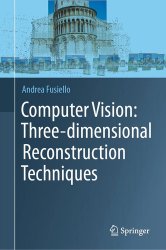Computer Vision: Three-dimensional Reconstruction Techniques
- Добавил: literator
- Дата: 31-12-2023, 08:49
- Комментариев: 0
 Название: Computer Vision: Three-dimensional Reconstruction Techniques
Название: Computer Vision: Three-dimensional Reconstruction TechniquesАвтор: Andrea Fusiello
Издательство: Springer
Год: 2024
Страниц: 348
Язык: английский
Формат: pdf (true), epub
Размер: 40.4 MB
From facial recognition to self-driving cars, the applications of computer vision are vast and ever-expanding. Geometry plays a fundamental role in this discipline, providing the necessary mathematical framework to understand the underlying principles of how we perceive and interpret visual information in the world around us.
This text explores the theories and computational techniques used to determine the geometric properties of solid objects through images. It covers the basic concepts and provides the necessary mathematical background for more advanced studies. The book is divided into clear and concise chapters covering a wide range of topics including image formation, camera models, feature detection and 3D reconstruction. Each chapter includes detailed explanations of the theory as well as practical examples to help the reader understand and apply the concepts presented.
Deep Learning has brought undeniable successes and some breakthroughs in image recognition and scene description. It is nevertheless true that geometric Computer Vision remains a fundamental field. Given the impressive state-of-the-art and the rapid pace of progress in Deep Learning, it would be of course risky to rule out the possibility that the solution to many geometric vision problems, for instance reconstructing 3D structure from multiple images, can be learned from millions of examples. Yet we believe that a principled, approach that obtains the geometric structure of what we see through applied mathematics provides more insight. We would also go as far as suggesting that, in the end, such an approach can be even more fun to study and implement.
Computer Vision was born as a branch of Artificial Intelligence (AI) in the 70s of the last century, essentially as a confluence of pattern recognition, signal and image processing, photogrammetry, perceptual psychology and neurophysiology/brain research, but has since evolved into an autonomous discipline with its own methods, paradigms and problems.
The book has been written with the intention of being used as a primary resource for students on university courses in Computer Vision, particularly final year undergraduate or postgraduate Computer Science or engineering courses. It is also useful for self-study and for those who, outside the academic field, find themselves applying Computer Vision to solve practical problems. The aim of the book is to strike a balance between the complexity of the theory and its practical applicability in terms of implementation. Rather than providing a comprehensive overview of the current state of the art, it offers a selection of specific methods with enough detail to enable the reader to implement them. To aid the reader in implementation, most of the methods discussed in the book are accompanied by a Matlab listing and the sources are available on Github.
Basic knowledge of linear algebra is necessary, while other mathematical concepts can be introduced as needed through included appendices.
Скачать Computer Vision: Three-dimensional Reconstruction Techniques
Внимание
Уважаемый посетитель, Вы зашли на сайт как незарегистрированный пользователь.
Мы рекомендуем Вам зарегистрироваться либо войти на сайт под своим именем.
Уважаемый посетитель, Вы зашли на сайт как незарегистрированный пользователь.
Мы рекомендуем Вам зарегистрироваться либо войти на сайт под своим именем.
Информация
Посетители, находящиеся в группе Гости, не могут оставлять комментарии к данной публикации.
Посетители, находящиеся в группе Гости, не могут оставлять комментарии к данной публикации.
